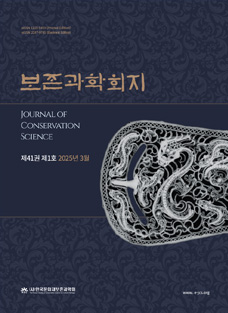Journal of Conservation Science Vol.27 No.1 pp.61-74
A Study of the Chemical Composition of Korean Traditional Ceramics (II) : Chosŏn Whiteware
한국 전통 도자기의 화학 조성에 대한 연구 (II) : 조선백자
Carolyn Kyongshin Koh,Woong Kil Choo,Sangdoo Ahn,Young Eun Lee,Gyu Ho Kim,Yeon Sook Lee
Abstract
The material characteristics of Chosŏn whiteware were investigated by analyzing and comparing the body and glaze compositions of whiteware shards excavated at the Kwangju royal kilns, Ch’unghyodong, and four other local-level kilns. In Korea, the rise of whiteware technology began in the early years of the Chosŏn dynasty, when the indigenous tradition of Koryŏ celadon was strongly influenced by the whiteware aesthetics of the Chinese Ming dynasty. The Kwangju royal kilns eventually made hard-textured whiteware of a quality equivalent to that of the Chinese by using a type of porcelain stone that contained slightly less Fe2O3 and TiO2 and slightly more K2O than that used for celadon. In contrast, the potters of Ch’unghyodong achieved the same level of quality by finding and using a totally different material: kaolinitic clay. The porcelain stone used at the Kwangju kiln was commonly found in Korea and south China, whereas kaolinitic clay (which has a high aluminum content) was typically found in north China, and was only rarely used in Korea. The flux component of the glaze compositions was mostly limestone, first in burnt form and later in crushed form, and the clay component was often glaze stone, which was a finer-grained porcelain stone with a higher proportion of feldspar. In the future, this comparative analytical study of Korean whiteware components should be extended to the18thand 19th-century kilns that are currently being excavated at a rapid pace.

 E-Submission
E-Submission 
 E-Submission
E-Submission 
![]() Journal Search Engine
Journal Search Engine




 KSC
KSC